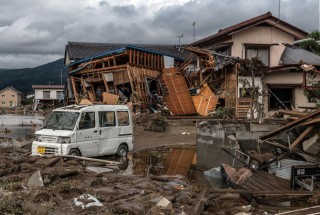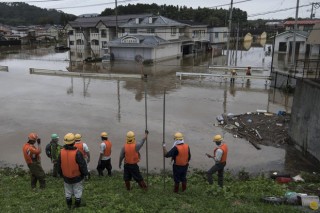Loading
Search
▼ As Japan Digs Out After Killer Typhoon Hagibis, More Rain Is On The Way
- Category:Other
Tokyo — Less than a week after being hit by the worst typhoon in decades, Japan was bracing on Thursday for a secondary disaster. Heavy rain was forecast to hit already-inundated areas in the coming days.
Officials said additional precipitation could destabilize storm walls along swollen rivers and trigger more landslides, with recovery efforts barely underway and a full picture of the devastation wrought by Typhoon Hagibis just starting to emerge.
The Ministry of Land, Infrastructure, Transport and Tourism said more than 56,000 acres across eastern and northeastern parts of Japan's main island of Honshu were flooded by the super typhoon. More than 100 river embankments collapsed during and immediately after the storm struck last weekend, causing 33,000 homes to flood. Almost 2,000 houses were partially or totally destroyed.
More than 77 deaths have been blamed on the storm, and hopes were fading fast that any of the approximately 10 people still listed as missing would be found alive. Thousands remained in shelters on Thursday, often shivering through the night as temperatures drop.
Prime Minister Shinzo Abe met residents in Fukushima Prefecture, where the Abukuma River burst its banks and left the highest regional death toll from the disaster. The government has allotted $6.5 million for its emergency response and may augment that with extra funds for reconstruction. More than 30,000 members of Japan's Self-Defense Forces have been called up to assist search and rescue efforts.
In the city of Koriyama, in Fukushima, residents have gathered in shelters including the gym floor of the Takase elementary school. Futons for 98 people are folded neatly beneath the basketball hoops.
The laborious job of removing mud from homes and businesses started early in the morning Thursday, as heavy digging equipment was used in a race to restore storm walls and roads. In the Yanagawa area, a construction worker told CBS News' partner network TBS he was "extremely worried. We've got to work as quickly as possible." Then there's the mess left behind; the Environment Ministry said it expected millions of tons of ruined appliances, cars, plastic bottles and other waste and debris to pile up from the 11 prefectures hit by the typhoon, which will take years to dispose of. The government is considering asking countries outside the disaster area to accept some of the garbage in order to speed up disposal.
In Marumori, Miyagi Prefecture, where the flood water reached as high as 75 feet and mudslides hit 150 locations, search and rescue efforts were being hampered by broken roadways. Earth-moving vehicles haven't been able to get in and remove debris in some remote hamlets accessible only by narrow roads.
A 36-year-old man, Keita Otsuki, paused to speak with reporters where his childhood home once stood. His mother, aunt and grandmother were among the town's five residents still listed as missing. His grandfather's body was discovered a few days earlier. He showed reporters a fragment from a family photo he pulled from the mud.
"I still can't believe it," he said. "When I look at the picture, I know my house was here. I'm at a loss for words."
One evacuee's harrowing experience Tochigi Prefecture was captured by his car's dash-cam.
The man and his wife, both in their sixties, were headed for an evacuation center just across rice paddies from their home on the evening of the typhoon. They were terrified to find the service road through the paddies had become a rushing river. They managed to pry open the doors and stumble to safety before their car was swept away, but as they did so they found another disabled vehicle. The driver, an 85-year-old woman, had died.
"We should have heeded the warnings to evacuate early," the man told TBS.
Experts say levees around Tokyo held up well this time, but they're warning the capital's decades-old flood defenses may be no match for the more frequent and more powerful typhoons the Earth's warming climate is delivering.
A worst-case simulation, with torrential rain and tidal flooding hitting the Japanese capital simultaneously, found that a third of the city would be submerged, including the Ginza — Japan's Fifth Avenue — and Marunouchi, the heart of Japan's finance and corporate district.
A scary video produced by the government in 2017 (above), based on that model, shows the effects of a theoretical levee breach along Tokyo's Arakawa River.
In the model, the flooding kills 4,000 people and paralyzes the capital, and it is starting to seem more frighteningly real than ever.
- October 18, 2019
- Comment (0)
- Trackback(0)



